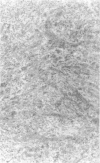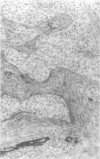Abstract
AIM: To evaluate the intracellular and peritumoral expression of matrix proteins in squamous cell carcinoma of the uterine cervix using immunohistochemistry. METHODS: 71 squamous cell carcinomas and 10 controls were stained for laminin, fibronectin, and collagen IV. Cytoplasmic staining in tumour cells and peritumoral deposition of matrix proteins were evaluated. The association between staining results and patient age, tumour stage, histological grade, and survival was studied. RESULTS: Positive cytoplasmic staining for laminin, fibronectin, and collagen IV was observed in 17 (23.9%), 27 (38%), and 10 (14.1%) cases, respectively. Staining for laminin was most pronounced in the invasive front of tumour islands, while for fibronectin and collagen IV it appeared to be diffuse. Peritumoral staining for laminin and collagen IV was detected in 12 cases (16.9%). Early stage (Ia1-Ia2) tumours were uniformly negative for all three proteins. Cytoplasmic staining for laminin correlated with positive staining for fibronectin and collagen IV, and with the presence of a peritumoral deposition of collagen IV and laminin. There was no correlation with any of the three markers between staining results and patient age, stage, grade, or survival. CONCLUSIONS: Expression of extracellular matrix proteins in some cervical squamous cell carcinomas might reflect the enhanced ability of these tumours to modify the peritumoral stroma. This ability seems to be absent in early stage tumours. The correlation between intracytoplasmic and peritumoral expression of matrix proteins supports the evidence of their synthesis by tumour cells. However, this property did not correlate with disease outcome in this study.
Full text
PDF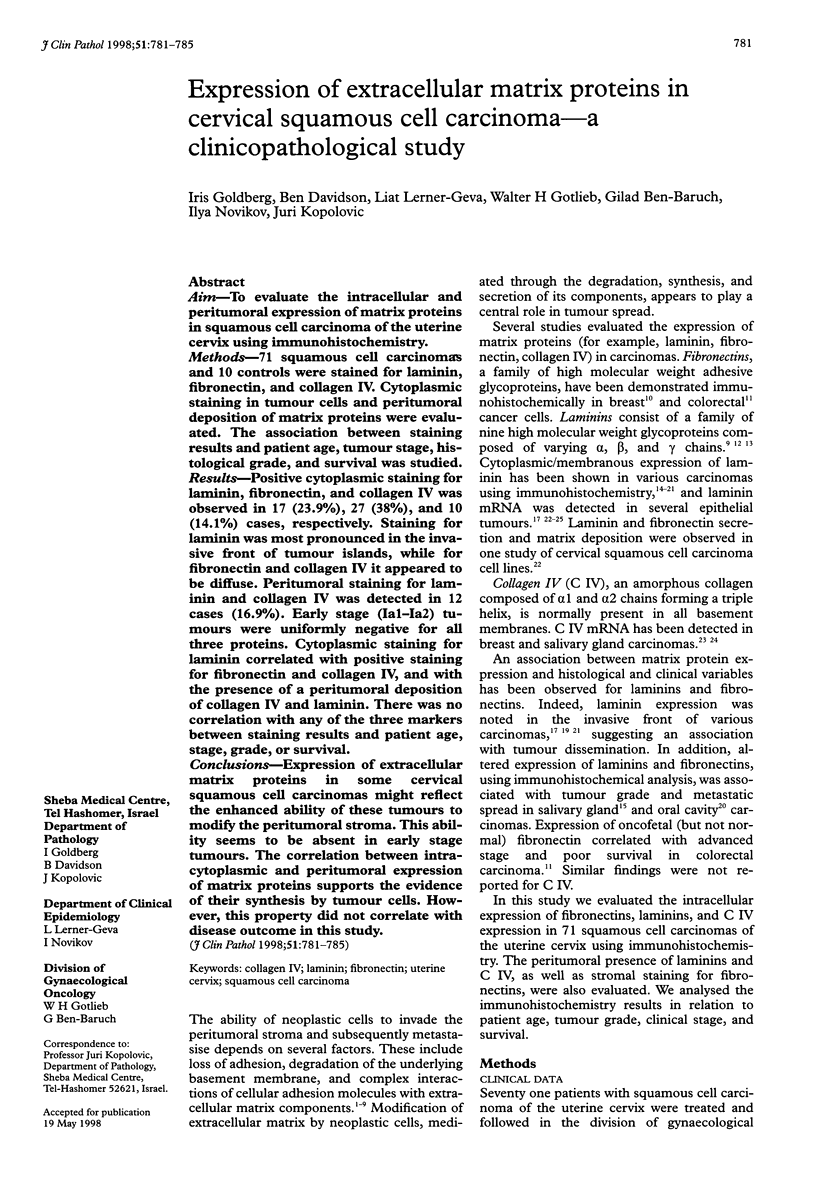
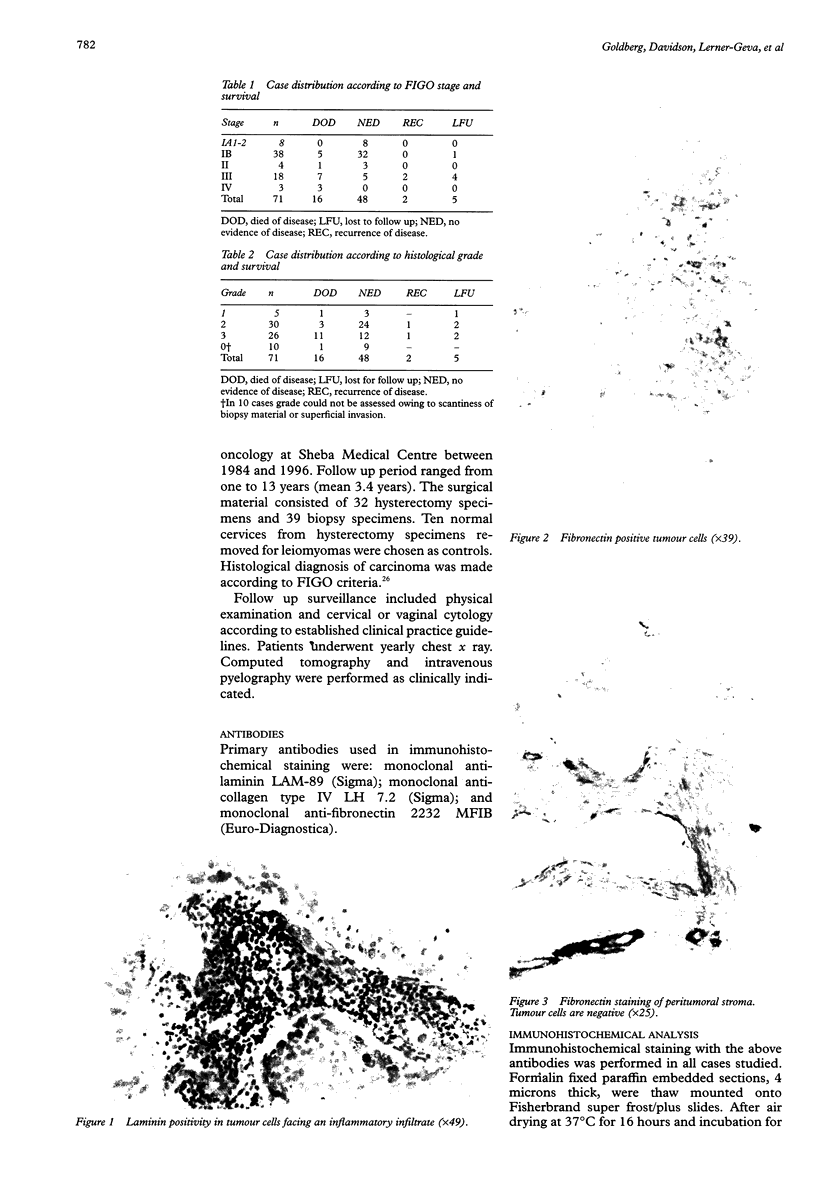
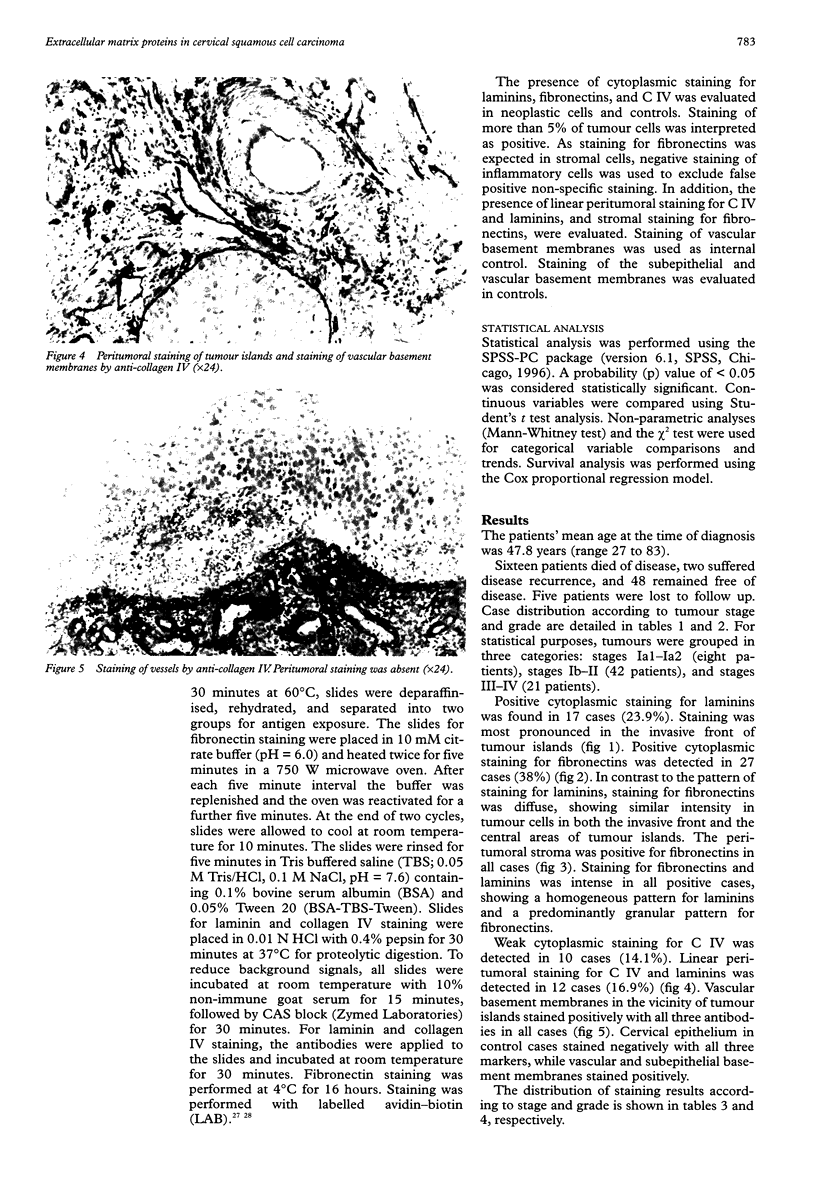

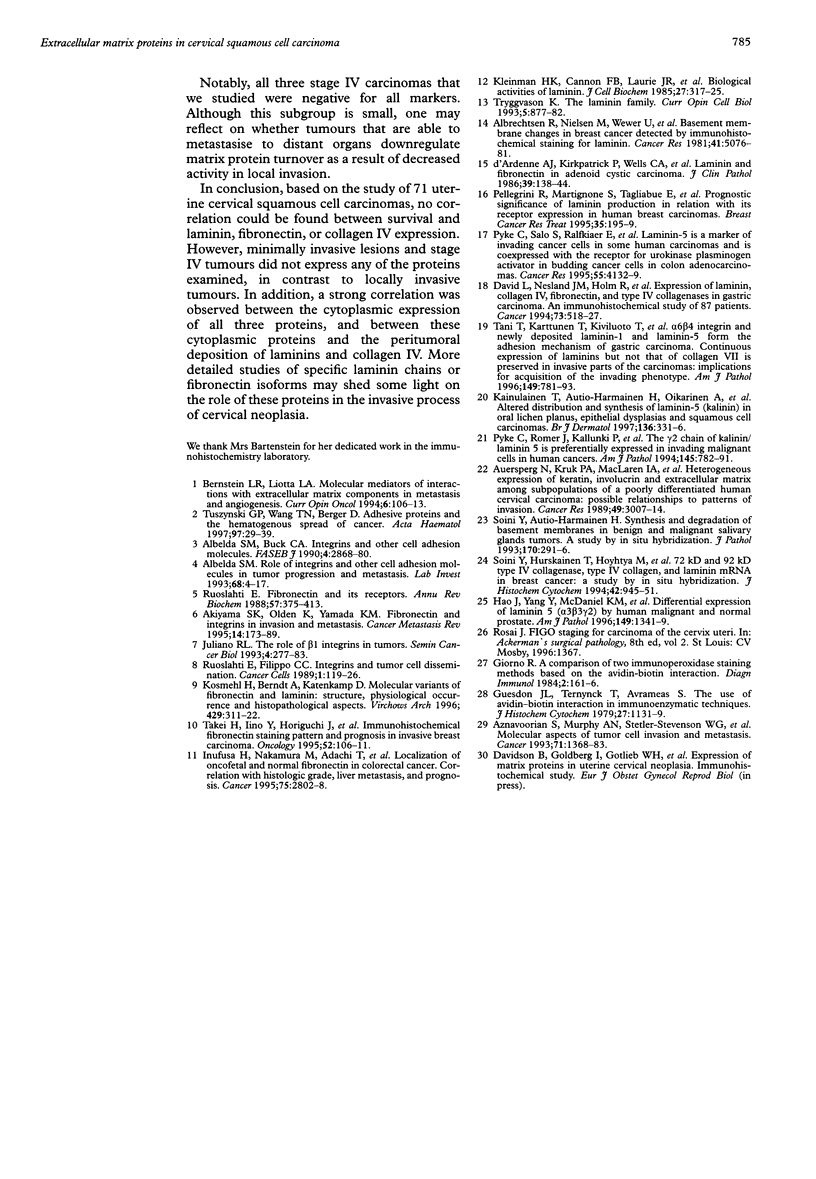
Images in this article
Selected References
These references are in PubMed. This may not be the complete list of references from this article.
- Akiyama S. K., Olden K., Yamada K. M. Fibronectin and integrins in invasion and metastasis. Cancer Metastasis Rev. 1995 Sep;14(3):173–189. doi: 10.1007/BF00690290. [DOI] [PubMed] [Google Scholar]
- Albelda S. M., Buck C. A. Integrins and other cell adhesion molecules. FASEB J. 1990 Aug;4(11):2868–2880. [PubMed] [Google Scholar]
- Albelda S. M. Role of integrins and other cell adhesion molecules in tumor progression and metastasis. Lab Invest. 1993 Jan;68(1):4–17. [PubMed] [Google Scholar]
- Albrechtsen R., Nielsen M., Wewer U., Engvall E., Ruoslahti E. Basement membrane changes in breast cancer detected by immunohistochemical staining for laminin. Cancer Res. 1981 Dec;41(12 Pt 1):5076–5081. [PubMed] [Google Scholar]
- Auersperg N., Kruk P. A., MacLaren I. A., Watt F. M., Mydral S. E. Heterogeneous expression of keratin, involucrin, and extracellular matrix among subpopulations of a poorly differentiated human cervical carcinoma: possible relationships to patterns of invasion. Cancer Res. 1989 Jun 1;49(11):3007–3014. [PubMed] [Google Scholar]
- Aznavoorian S., Murphy A. N., Stetler-Stevenson W. G., Liotta L. A. Molecular aspects of tumor cell invasion and metastasis. Cancer. 1993 Feb 15;71(4):1368–1383. doi: 10.1002/1097-0142(19930215)71:4<1368::aid-cncr2820710432>3.0.co;2-l. [DOI] [PubMed] [Google Scholar]
- Bernstein L. R., Liotta L. A. Molecular mediators of interactions with extracellular matrix components in metastasis and angiogenesis. Curr Opin Oncol. 1994 Jan;6(1):106–113. doi: 10.1097/00001622-199401000-00015. [DOI] [PubMed] [Google Scholar]
- Cairns J. The evolution of cancer research. Cancer Cells. 1989 Sep;1(1):1–8. [PubMed] [Google Scholar]
- David L., Nesland J. M., Holm R., Sobrinho-Simões M. Expression of laminin, collagen IV, fibronectin, and type IV collagenase in gastric carcinoma. An immunohistochemical study of 87 patients. Cancer. 1994 Feb 1;73(3):518–527. doi: 10.1002/1097-0142(19940201)73:3<518::aid-cncr2820730305>3.0.co;2-t. [DOI] [PubMed] [Google Scholar]
- Giorno R. A comparison of two immunoperoxidase staining methods based on the avidin-biotin interaction. Diagn Immunol. 1984;2(3):161–166. [PubMed] [Google Scholar]
- Guesdon J. L., Ternynck T., Avrameas S. The use of avidin-biotin interaction in immunoenzymatic techniques. J Histochem Cytochem. 1979 Aug;27(8):1131–1139. doi: 10.1177/27.8.90074. [DOI] [PubMed] [Google Scholar]
- Hao J., Yang Y., McDaniel K. M., Dalkin B. L., Cress A. E., Nagle R. B. Differential expression of laminin 5 (alpha 3 beta 3 gamma 2) by human malignant and normal prostate. Am J Pathol. 1996 Oct;149(4):1341–1349. [PMC free article] [PubMed] [Google Scholar]
- Inufusa H., Nakamura M., Adachi T., Nakatani Y., Shindo K., Yasutomi M., Matsuura H. Localization of oncofetal and normal fibronectin in colorectal cancer. Correlation with histologic grade, liver metastasis, and prognosis. Cancer. 1995 Jun 15;75(12):2802–2808. doi: 10.1002/1097-0142(19950615)75:12<2802::aid-cncr2820751204>3.0.co;2-o. [DOI] [PubMed] [Google Scholar]
- Juliano R. L. The role of beta 1 integrins in tumors. Semin Cancer Biol. 1993 Oct;4(5):277–283. [PubMed] [Google Scholar]
- Kainulainen T., Autio-Harmainen H., Oikarinen A., Salo S., Tryggvason K., Salo T. Altered distribution and synthesis of laminin-5 (kalinin) in oral lichen planus, epithelial dysplasias and squamous cell carcinomas. Br J Dermatol. 1997 Mar;136(3):331–336. [PubMed] [Google Scholar]
- Kleinman H. K., Cannon F. B., Laurie G. W., Hassell J. R., Aumailley M., Terranova V. P., Martin G. R., DuBois-Dalcq M. Biological activities of laminin. J Cell Biochem. 1985;27(4):317–325. doi: 10.1002/jcb.240270402. [DOI] [PubMed] [Google Scholar]
- Kosmehl H., Berndt A., Katenkamp D. Molecular variants of fibronectin and laminin: structure, physiological occurrence and histopathological aspects. Virchows Arch. 1996 Dec;429(6):311–322. doi: 10.1007/BF00198435. [DOI] [PubMed] [Google Scholar]
- Pellegrini R., Martignone S., Tagliabue E., Belotti D., Bufalino R., Cascinelli N., Ménard S., Colnaghi M. I. Prognostic significance of laminin production in relation with its receptor expression in human breast carcinomas. Breast Cancer Res Treat. 1995 Aug;35(2):195–199. doi: 10.1007/BF00668209. [DOI] [PubMed] [Google Scholar]
- Pyke C., Rømer J., Kallunki P., Lund L. R., Ralfkiaer E., Danø K., Tryggvason K. The gamma 2 chain of kalinin/laminin 5 is preferentially expressed in invading malignant cells in human cancers. Am J Pathol. 1994 Oct;145(4):782–791. [PMC free article] [PubMed] [Google Scholar]
- Pyke C., Salo S., Ralfkiaer E., Rømer J., Danø K., Tryggvason K. Laminin-5 is a marker of invading cancer cells in some human carcinomas and is coexpressed with the receptor for urokinase plasminogen activator in budding cancer cells in colon adenocarcinomas. Cancer Res. 1995 Sep 15;55(18):4132–4139. [PubMed] [Google Scholar]
- Ruoslahti E. Fibronectin and its receptors. Annu Rev Biochem. 1988;57:375–413. doi: 10.1146/annurev.bi.57.070188.002111. [DOI] [PubMed] [Google Scholar]
- Soini Y., Autio-Harmainen H. Synthesis and degradation of basement membranes in benign and malignant salivary gland tumours. A study by in situ hybridization. J Pathol. 1993 Jul;170(3):291–296. doi: 10.1002/path.1711700312. [DOI] [PubMed] [Google Scholar]
- Soini Y., Hurskainen T., Höyhtyä M., Oikarinen A., Autio-Harmainen H. 72 KD and 92 KD type IV collagenase, type IV collagen, and laminin mRNAs in breast cancer: a study by in situ hybridization. J Histochem Cytochem. 1994 Jul;42(7):945–951. doi: 10.1177/42.7.8014478. [DOI] [PubMed] [Google Scholar]
- Takei H., Iino Y., Horiguchi J., Yokoe T. Immunohistochemical fibronectin staining pattern and prognosis in invasive breast carcinoma. Oncology. 1995 Mar-Apr;52(2):106–111. doi: 10.1159/000227439. [DOI] [PubMed] [Google Scholar]
- Tani T., Karttunen T., Kiviluoto T., Kivilaakso E., Burgeson R. E., Sipponen P., Virtanen I. Alpha 6 beta 4 integrin and newly deposited laminin-1 and laminin-5 form the adhesion mechanism of gastric carcinoma. Continuous expression of laminins but not that of collagen VII is preserved in invasive parts of the carcinomas: implications for acquisition of the invading phenotype. Am J Pathol. 1996 Sep;149(3):781–793. [PMC free article] [PubMed] [Google Scholar]
- Tryggvason K. The laminin family. Curr Opin Cell Biol. 1993 Oct;5(5):877–882. doi: 10.1016/0955-0674(93)90038-r. [DOI] [PubMed] [Google Scholar]
- Tuszynski G. P., Wang T. N., Berger D. Adhesive proteins and the hematogenous spread of cancer. Acta Haematol. 1997;97(1-2):29–39. doi: 10.1159/000203657. [DOI] [PubMed] [Google Scholar]
- d'Ardenne A. J., Kirkpatrick P., Wells C. A., Davies J. D. Laminin and fibronectin in adenoid cystic carcinoma. J Clin Pathol. 1986 Feb;39(2):138–144. doi: 10.1136/jcp.39.2.138. [DOI] [PMC free article] [PubMed] [Google Scholar]



